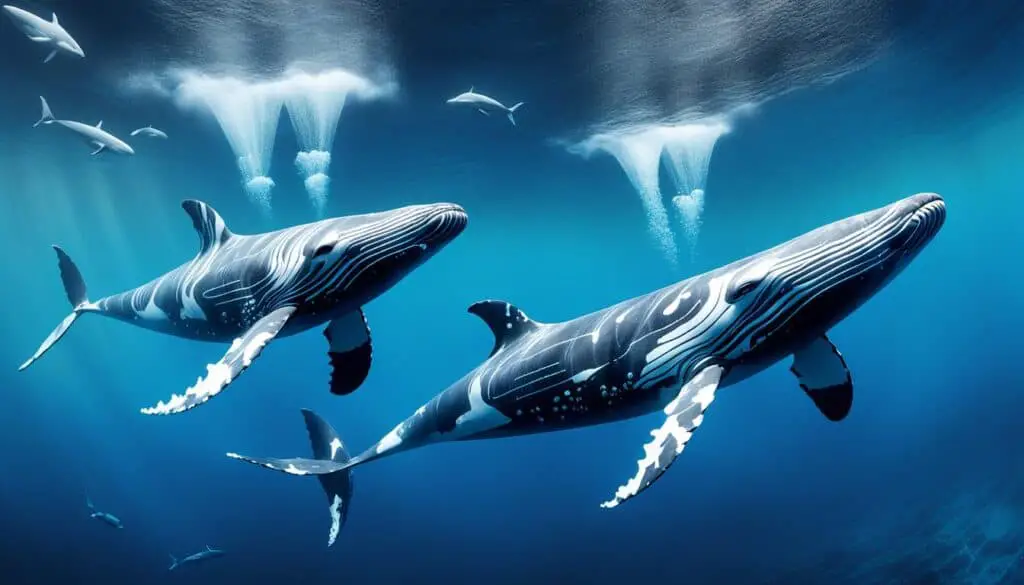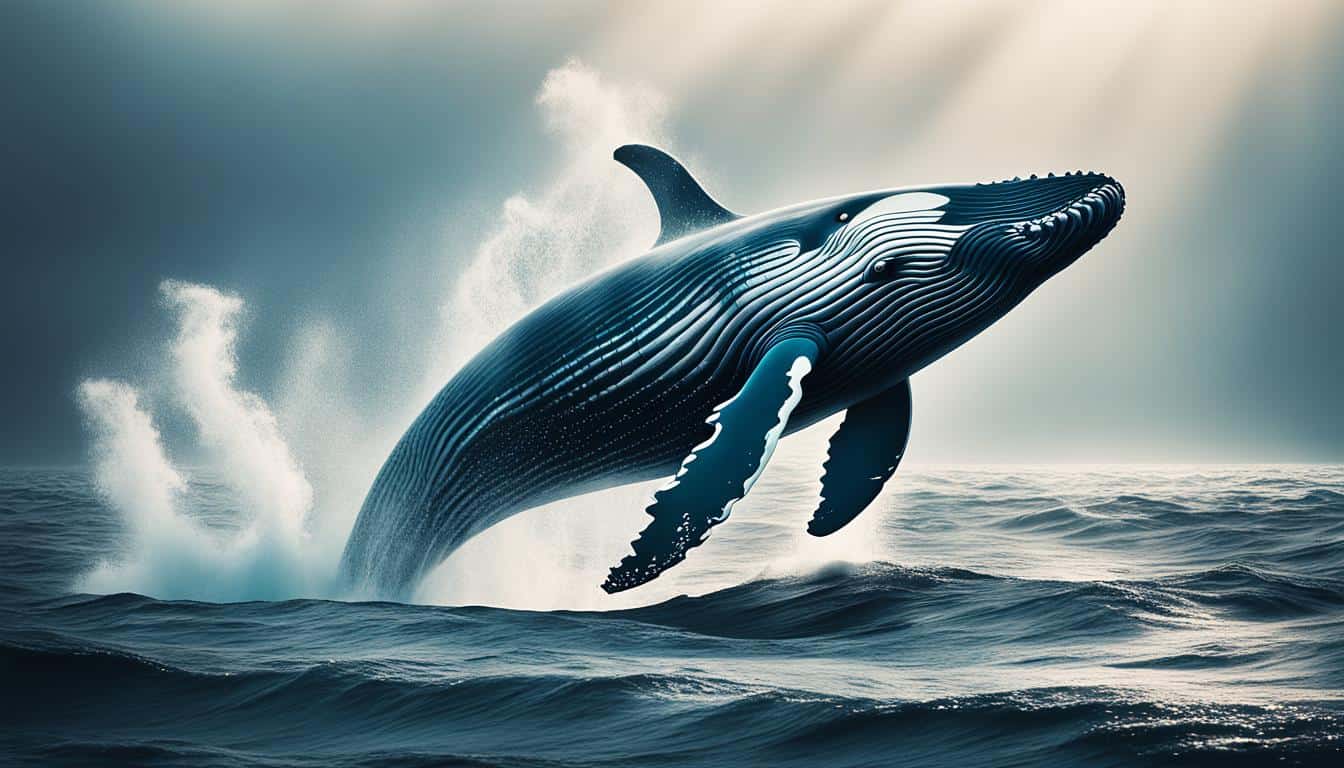Have you ever wondered about the enchanting melodies in our oceans? What is whale song? These sounds, mainly from baleen whales like humpbacks, intrigue researchers and ocean lovers. Whale communication is more than just noise. It’s a complex language with depth and richness, possibly holding secrets to their social lives.
Learning about marine animal sounds can help us understand the challenges whales face in a noisy ocean. New studies show these sounds are crucial for mating and finding their way. As we dive deeper, you’ll learn how whales create these amazing songs.
Understanding Cetacean Communication
Cetaceans, like whales and dolphins, are experts in ocean communication. Sound is key in their world, which is often dark and deep. They use vocalizations to send messages, find their way, and connect with others. Since sound moves faster in water than in air, it’s the main way they talk to each other.
The Role of Sound in the Ocean
Sound is crucial for whales underwater. They use it for navigation, finding food, and talking to each other. These sounds do more than just help them communicate. They keep their social groups together and help with finding a mate. Being able to make and understand these sounds is vital for their survival in the big ocean.
Differences Between Toothed and Baleen Whales
There are two main types of cetaceans: toothed and baleen whales. Each has its own way of making sounds. Toothed whales, or odontocetes, use echolocation to find food and move around. They make sounds with air sacs near their blowholes.
Baleen whales, like humpbacks, make low-frequency sounds with a special larynx. This lets them talk over long distances. It shows how different whales have unique ways of communicating.
What is Whale Song?
Whale songs, especially those from humpback whales, amaze both researchers and fans. These sounds show how complex whale communication is. They reveal the beauty and depth of sounds from the sea.
The Unique Nature of Humpback Whale Songs
Humpback whale songs are known for their long and complex nature. These songs can last up to 22 hours, filled with different phrases and patterns. Males sing these songs during the breeding season to attract mates or show off to rivals.
This behavior shows how important these songs are in whale communication. They help shape the social life of whales.
The Complex Structure of Whale Vocalizations
Whale vocalizations are a key part of marine biology. Humpback whales make sounds with both high and low frequencies. This lets their songs travel far through the ocean.
Studies have found that baleen whales have a special U-shaped larynx. This helps them make unique sounds. This feature is key to the complex sounds of whales.
| Characteristic | Humpback Whale Songs | Other Whale Species |
|---|---|---|
| Length of Performance | Up to 22 hours | Varies (typically shorter) |
| Primary Singers | Males during breeding | Both males and females, depending on species |
| Common Frequencies | High and low frequencies | Predominantly low frequencies |
| Sound Production Mechanism | U-shaped larynx | Varies by species |
Whale Communication and Acoustic Signals
Learning how whales talk to each other helps us understand their complex social lives. These huge sea creatures make sounds to survive and connect with others. They use sound waves under water to find food, stay together, and talk to their pod.
How Whales Create Sound
Whales make sounds with special body parts. Baleen whales use their voice box to make low sounds. This box vibrates, sending out sounds that can travel for thousands of miles. These sounds are key for finding a mate and staying in touch in the deep sea.
The Importance of Low-Frequency Sounds
Low sounds are very important for whales. They go deep and far, helping whales talk to each other. As humans make more noise in the ocean, we need to protect these sounds. This way, whales can keep talking to each other in their homes.

| Type of Whale | Sound Production Method | Frequency Range | Communication Purpose |
|---|---|---|---|
| Baleen Whales | Larynx | Low-Frequency (10-100 Hz) | Mating, Social Interaction |
| Toothed Whales | Spermaceti Organ | Varied (up to 20 kHz) | Echolocation, Social Calls |
Humpback Whale Songs: A Deeper Dive
Exploring Humpback whale songs reveals complex patterns and themes. These songs are not just sounds. They are structures that change over time, showing how whales communicate. They also show how whale groups adapt by adding new parts to their songs.
Patterns and Themes in Whale Songs
Humpback whale songs have distinct melodies with important patterns. These songs often have repetitive phrases with special meanings for certain groups. Researchers see changes in these songs every year, showing they are not fixed. This helps us understand how whales communicate socially.
The Evolution of Humpback Songs Over Time
The evolution of Humpback whale songs is key for conservation. Many whale populations are recovering from the harm of whaling. Changes in their songs tell us about their health and social life. It’s important to protect their homes from noise and human harm. This way, whales can keep using their songs to communicate.
FAQ
What is whale song?
Whale song is the complex sounds made by marine mammals, like humpback whales. These songs can go on for up to 22 hours. They have intricate phrases and patterns that help whales communicate.
Why is understanding whale communication important?
Knowing how whales communicate is key to understanding their social lives. It shows the problems they face, like noise pollution that can mess with their sounds and social life.
How do whales communicate underwater?
Whales talk to each other using sound, which moves faster underwater than in air. Toothed whales and baleen whales use different ways to make sounds.
What are the differences between toothed and baleen whale sounds?
Toothed whales use echolocation and make sounds near their blowholes. Baleen whales, like humpbacks, have a special larynx that lets them make low sounds for long-distance talks.
How do humpback whale songs evolve?
Humpback whale songs change over time, showing a cultural side to their communication. Researchers have seen new phrases added to songs, showing how dynamic whale communication is.
What role do low-frequency sounds play in whale communication?
Low sounds are key for long-distance talks in the ocean. They help with mating and social stuff, even when it’s hard to see underwater.
How can noise pollution affect whale communication?
Noise pollution can mess with whales’ ability to talk to each other. Since these sounds are crucial for their survival and social life, we need to reduce noise to protect them.
What is the significance of eco-friendly whale watching?
Eco-friendly whale watching is important for protecting whales’ homes from human harm. By being responsible, we help whales keep doing their natural things and singing in peace.







